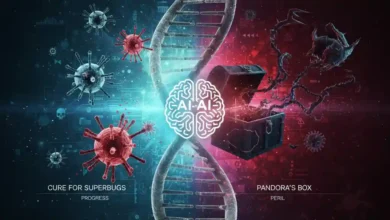CRISPR and the Dawn of a Genetic Renaissance

For centuries, humanity has dreamt of shaping its own destiny, of overcoming disease, and even enhancing its very being. That dream is rapidly transitioning into reality, not through mythical powers, but through the astounding precision of a technology called CRISPR. Far from a mere scientific tool, CRISPR is an earthquake rattling the foundations of biology, medicine, and ethics, promising a future where our genetic code is no longer a fixed fate, but a dynamic blueprint we can actively edit.
The Genetic Symphony: A Glimpse into the CRISPR Orchestra
Imagine a biological search-and-replace function, operating with unparalleled accuracy within the intricate symphony of our DNA. That’s essentially what CRISPR (Clustered Regularly Interspaced Short Palindromic Repeats) offers. At its core, CRISPR utilizes a guide RNA molecule that acts like a GPS, locating a specific DNA sequence, and a Cas9 enzyme (the molecular scissors) that precisely cuts the DNA at that location. This double-strand break then triggers the cell’s natural repair mechanisms, which can be hijacked to either:
- Delete: Remove faulty genetic sequences.
- Inactivate: Turn off problematic genes.
- Insert: Introduce new, desired genetic material.
This elegant simplicity belies its profound power, transforming the once laborious and imprecise art of genetic engineering into a targeted, efficient, and increasingly accessible science.
Beyond the Lab Bench: Real-World Applications Already Taking Root
The promise of CRISPR isn’t confined to scientific journals; its impact is already being felt across a multitude of fields:
1. Revolutionizing Medicine: A Cure on the Horizon?
The most immediate and profound impact of CRISPR is in the realm of human health. For individuals battling genetic disorders, CRISPR offers a beacon of hope:
- Sickle Cell Anemia & Thalassemia: Clinical trials are showing remarkable success in editing the genes responsible for these debilitating blood disorders, offering functional cures where only management existed before.
- Cystic Fibrosis: Researchers are actively exploring how to correct the faulty gene that leads to thick, sticky mucus buildup in the lungs and other organs.
- Huntington’s Disease: While complex, CRISPR holds potential for silencing the expanded gene that causes this neurodegenerative disorder.
- Cancer Immunotherapy: CRISPR is being used to engineer T-cells, enhancing their ability to recognize and destroy cancer cells with greater precision and efficacy.
These are just a few examples; the potential for treating countless other genetic conditions, from muscular dystrophy to rare metabolic disorders, is immense.
2. Supercharging Agriculture: A Sustainable Food Future
CRISPR isn’t just for human health; it’s a powerful ally in addressing global food security and sustainability:
- Disease-Resistant Crops: Scientists are developing crops that can withstand devastating diseases, reducing pesticide use and increasing yields. Imagine blight-resistant potatoes or mildew-proof grapes.
- Enhanced Nutritional Value: CRISPR can boost the nutritional content of staple crops, creating “superfoods” rich in vitamins and minerals to combat malnutrition.
- Climate Resilience: Engineering plants to better tolerate drought, salinity, and extreme temperatures can safeguard agricultural output in a changing climate.
- Allergen-Free Foods: Efforts are underway to remove allergens from common foods like peanuts and wheat, making them safer for a wider population.
3. Protecting Our Planet: Conservation and Beyond
The reach of CRISPR extends even to environmental conservation and our fight against climate change:
- Pest Control: “Gene drives” using CRISPR could rapidly spread genetic modifications through pest populations, rendering them sterile or less harmful, potentially saving endangered species from invasive predators.
- Disease Vector Control: Modifying mosquitoes to be resistant to malaria or dengue fever could eradicate these devastating diseases in affected regions.
- De-extinction (Theoretically): While highly controversial and complex, the technology theoretically offers a pathway to reintroduce extinct species by editing the DNA of closely related living organisms.
The Ethical Crucible: Navigating Uncharted Waters
With immense power comes immense responsibility. CRISPR’s ability to fundamentally alter life raises profound ethical, social, and philosophical questions that we, as a global society, must confront head-on:
- Germline Editing: The most contentious debate revolves around editing “germline” cells (sperm, egg, or early embryos), which would lead to heritable changes passed down to future generations. This opens the door to “designer babies” and raises concerns about exacerbating social inequalities and unintended consequences on the human gene pool.
- Accessibility and Equity: Who will have access to these life-altering technologies? Will genetic therapies become a luxury for the wealthy, creating a new form of health disparity?
- Unforeseen Consequences: While precise, CRISPR isn’t infallible. Off-target edits and mosaicism (where not all cells are edited) are ongoing concerns. The long-term ecological impacts of gene drives are also still being studied.
- Playing God? For many, the idea of directly altering human DNA trespasses into sacred territory, prompting deep moral and religious reflection.
The Road Ahead: A Future Shaped by Our Choices
CRISPR is not a magic wand; it’s a powerful tool that demands careful stewardship. The future of genetic engineering will be defined not just by scientific breakthroughs, but by the societal frameworks we establish, the ethical boundaries we uphold, and the global conversations we foster.
The pace of innovation is staggering. Next-generation CRISPR systems are emerging, offering even greater precision and versatility, such as prime editing (which can “write” new DNA sequences without double-strand breaks) and base editing (which changes single DNA “letters”).
We stand at the precipice of a genetic renaissance, a transformative era where we can, for the first time, truly rewrite the code of life. How we choose to wield this power will determine whether CRISPR ushers in a golden age of health and sustainability or leads us down unforeseen and challenging paths. The conversation starts now, for the future is not just arriving; it’s being actively engineered.
Follow Odinozz on social media. Click here.



